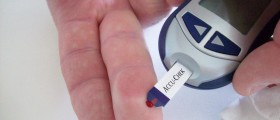
Diabetic ketoacidosis is a serious complication affecting people suffering from diabetes which occurs once the level of sugar in blood becomes too high. Namely, in patients in whom there is not sufficient amount of insulin, sugar cannot enter body cells and fulfill its purpose. Instead, the body starts burning fat for energy. As a result, the level of ketones rises. The level of these end-products of fat metabolism significantly increases in the blood and they are also excreted excessively via the urine. Ketones are harmful for the body and even though they are eliminated via urine there is still, plenty left in the blood causing all the symptoms and signs of ketoacidosis.
Warning Symptoms and Signs of Ketoacidosis
Ketoacidosis develops gradually. However, once the person starts vomiting, further progression of the condition may be quite rapid. This is the reason why people must recognize warning signs of ketoacidosis and act promptly to correct this metabolic imbalance.
Patients typically complain about thirst and have dry mouth. There is also frequent urination, high level of sugar in blood and high level of ketones in the urine. The last two can be checks only with certain tests.
The person is exhausted, his/her skin becomes very dry and flushed and they eventually start feeling nauseated, vomit and experience abdominal pain.
Progression of ketoacidosis is blamed for breathing difficulties (short and deep breaths), fruit odor on breath and confusion.
The condition represents a medical emergency and requires prompt treatment and hospitalization.
Recognizing Ketoacidosis
By being familiar with all symptoms and signs of ketoacidosis, a passer-by may help the affected individual and seek medical attention. Laboratory tests (both blood and urine tests) easily confirm ketoacidosis. There are also a simple urine test that can be performed at home, measuring the level of ketones in urine, if necessary. Such testing should be performed when diabetic patients have a cold or flu, i.e. when the risk for ketoacidosis increases.
Who is at Risk?
Ketoacidosis only affects patients suffering from type I diabetes and under certain circumstances.
The main reason behind this medical issue is lack of insulin. There are many explanation why the level of insulin in the blood is not optimal to control the level of sugar. For instance, a person may have forgotten to inject insulin. Furthermore, ketoacidosis may occur if a patient is suffering from a severe infection and some other illnesses. Dehydration is another trigger of ketoacidosis.
So, in the mentioned situations, patients are advised to check the amount of ketones in urine and pay even more attention to the level of sugar in their blood.

















Your thoughts on this
Loading...